Had I the power that some say Dian had,
Thy temples should be planted presently
With horns, as was Actaeon's; and the hounds
Should drive upon thy new-transformed limbs,
Unmannerly intruder as thou art!
Shakespeare , Titus Andronicus 2.3.61
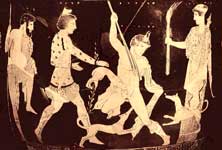
Zeus, Lyssa, Actaeon and Artemis
In Greek mythology, Actaeon (Greek: Aktaion, Ακταίωνας), son of the priestly herdsman Aristaeus and Autonoe in Boeotia, was a famous Theban hero,[1] trained by the centaur Chiron,[2] who suffered the fatal wrath of Artemis (later her Roman counterpart Diana). The surviving details of his transgression vary: "the only certainty is in what Aktaion suffered, his πάθος, and what Artemis did: the hunter became the hunted; he was transformed into a stag, and his raging hounds, struck with a 'wolf's frenzy' (λύσσα), tore him apart as they would a stag."[3] This is the iconic motif by which Actaeon is recognized, both in ancient art and in Renaissance and post-Renaissance depictions.
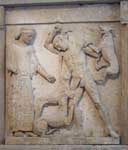
Artemis and Actaeon, Temple E, Selinunte
The plot
Greek literature accounts for the hostility of Artemis in various ways. In the version that was offered by the Hellenistic poet Callimachus (Hymn v), which has become the standard setting, Artemis was bathing in the woods near Boeotian Orchomenos[4] when the hunter Actaeon stumbled across her, thus seeing her naked. He stopped and stared, amazed at her ravishing beauty. Once seen, Actaeon was punished by Artemis: she forbade him speech — if he tried to speak, he would be changed into a stag — for the unlucky profanation of her virginity's mystery. Upon hearing the call of his hunting party, he cried out to them and immediately was changed into a stag. His own hounds then turned upon him and tore him to pieces. An element of the earlier myth made Actaeon the familiar hunting companion of Artemis, no stranger. In an embroidered extension of the myth, the hounds were so upset with their master's death, that Chiron made a statue so lifelike that the hounds thought it was Actaeon.[5]
There are various other versions: Bibliotheke states that his offense was that he was a rival of Zeus for Semele, his mother's sister,[6] whereas in Euripides' Bacchae he has boasted that he is a better hunter than Artemis:[7]
| ὁρᾷς τὸν Ἀκτέωνος ἄθλιον μόρον, ὃν ὠμόσιτοι σκύλακες ἃς ἐθρέψατο διεσπάσαντο, κρείσσον' ἐν κυναγίαις Ἀρτέμιδος εἶναι κομπάσαντ', ἐν ὀργάσιν |
Look at Actaeon's wretched fate who by the man-eating hounds he had raised, was torn apart, better at hunting than Artemis he had boasted to be, in the meadows |
Further materials, including fragments that belong with the Hesiodic Catalogue of Women and at least four Attic tragedies, including a Toxotides of Aeschylus, have been lost.[8] Diodorus Siculus (4.81.4), in a variant of Actaeon's hubris that has been largely ignored, has it that Actaeon wanted to marry Artemis. Other authors say the hounds were Artemis' own; some lost elaborations of the myth seem to have given them all names and narrated their wanderings after his loss.

12767 : White-Ground Alabastron. Actaeon
According to the Latin version of the story told by the Roman Ovid[9] having accidentally seen Diana (Artemis) on Mount Cithaeron while she was bathing, he was changed by her into a stag, and pursued and killed by his fifty hounds. This version also appears in Callimachus' Fifth Hymn, as a mythical parallel to the blinding of Tiresias after he sees Athena bathing.
The literary testimony of Actaeon's myth is largely lost, but Lamar Ronald Lacy,[10] deconstructing the myth elements in what survives and supplementing it by iconographic evidence in late vase-painting, made a plausible reconstruction of an ancient Actaeon myth that Greek poets may have inherited and subjected to expansion and dismemberment. His reconstruction opposes a too-pat consensus that has an archaic Actaeon aspiring to Semele, a classical Actaeon boasting of his hunting prowess and a Hellenistic Actaeon glimpsing Artemis' bath.[11] The righteous hunter, the companion of Artemis, seeing her bathing naked at the spring, was moved to try to make himself her consort, as Diodorus Siculus noted, and was punished, in part for transgressing the hunter's "ritually enforced deference to Artemis" (Lacy 1990:42).
Actaeon torn by his hounds is a common theme in 5th century BC Greek art: in some vase paintings he is shown wearing a deerskin, in others antlers sprout from his head. Pictures of Artemis surprised by Actaeon while bathing are found among Pompeian wall paintings.
Actaeon in art
The theme was one of many revived in the Renaissance. See for example:
Divulge Page himself for a secure and wilful
Actaeon [cuckold]. Shakespeare, Merry Wives, etc., act iii. sc. 2 (1596).
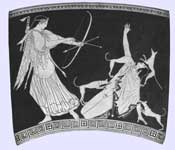
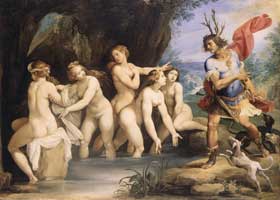
Actaeon and Artemis , Giuseppe Cesari (1606)
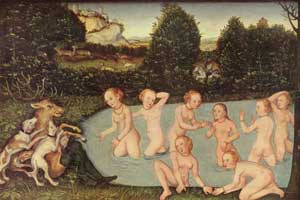
Diana and Actaeon, Lucas Cranach,
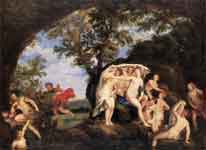
Diana and Actaeon, Francesco Albani
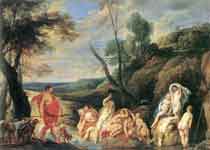
Diana and Actaeon, Jacob Jordaens c.1640
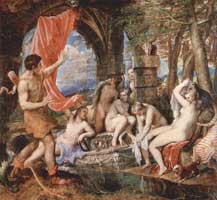
Actaeon suprises the bathing Diana, Titian
The Death of Actaeon , Titian, c. 1562
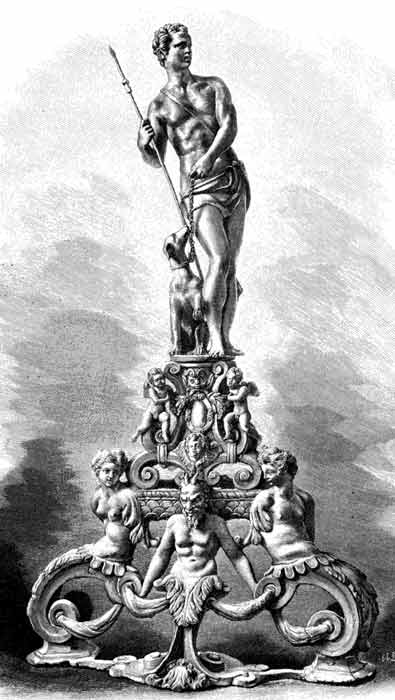
Actaeon, Ducal Palace , Venice
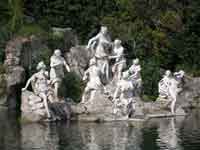
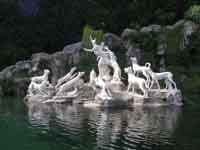
Ovid , Metamorphoses III, 193, Hyginus, Fabulae, 181.
Artemis and Actaeon from a Metope of the Temple E of Selinus
Actéon, an operatic pastorale by Marc-Antoine Charpentier.
the aria "Oft she visits this lone mountain" from Purcell's Dido and Aeneas, first performed in 1689 or earlier.
Giordano Bruno, "Gli Eroici Furori".
Notes
- ^ Through his mother he was a member of the ruling House of Cadmus.
- ^ Like Achilles of a later generation.
- ^ Walter Burkert, Homo Necans (1972), translated by Peter Bing (University of California Press) 1983, p 111.
- ^ Callimachus gives no site: a glen in the foothills of Mount Kithaeron near Boeotian Orchomenos, according to Euripides, Bacchae 1290-92, or a spring sanctuary near Plataea.
- ^ Fragmentary sources for the narrative of Actaeon's hounds are noted in Lacy 1990:30 note 32, 31 note 37.
- ^ Thus potentially endangering the future birth of Dionysus, had he been successful. Pausanias refered (9.2.3) to a lost poem by Stesichoros also expressing this motif. The progressive destruction of the House of Cadmus to make way for the advent of Dionysus can be followed in the myths of its individual members:Actaeon, Semele, Ino and Melicertes, and Pentheus.
- ^ This mytheme would link him with Agamemnon and Orion (Lacy 1990).
- ^ Lacy 1990, emphasizing that the central core is lost, covers the literary fragments, pp 26-27 and copious notes.
- ^ Ovid, Metamorphoses iii.131; see also pseudo-Apollodorus' Bibliotheke iii. 4
- ^ Lacy, "Aktaion and a Lost 'Bath of Artemis'" The Journal of Hellenic Studies 110 (1990), pp. 26-42.
- ^ Lacy 1990:27f. Lacy identifies the site of Actaeon's transgression as a spring sacred to Artemis at Plataea where Actaeon was a hero archegetes ("hero-founder") Plutarch, ''Aristeides''11.3-4.
Lamar Ronald Lacy, "Aktaion and a Lost 'Bath of Artemis'" The Journal of Hellenic Studies 110 (1990), pp. 26-42. Disentangles the conflicting fragments of Actaeon's myth.
See also : Greek Mythology. Paintings, Drawings
Retrieved from "http://en.wikipedia.org/"
All text is available under the terms of the GNU Free Documentation License
| Ancient Greece
Science, Technology , Medicine , Warfare, , Biographies , Life , Cities/Places/Maps , Arts , Literature , Philosophy ,Olympics, Mythology , History , Images Medieval Greece / Byzantine Empire Science, Technology, Arts, , Warfare , Literature, Biographies, Icons, History Modern Greece Cities, Islands, Regions, Fauna/Flora ,Biographies , History , Warfare, Science/Technology, Literature, Music , Arts , Film/Actors , Sport , Fashion --- |

